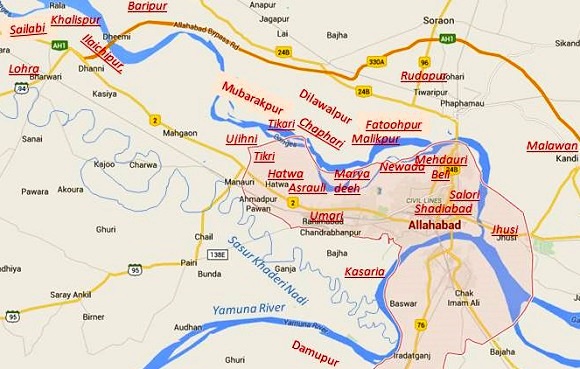
Villages and areas in and around Allahabad inhabited by our family branches are shown in red


Villages and areas in and around Allahabad inhabited by our family branches are shown in red
These pages are all about our family’s roots in and around Allahabad. When the idea developed that we could juxtapose the name of our project into ‘Sangam’ we were thrilled.
Sangam is a very uniquely Allahabad thing. It is the confluence of rivers Ganges and Jumna/Yamuna on the southeast side of the city. Legend has it that a subterranean river also flows into the same confluence. Enshrined by our folklore, romanticized in songs it has become a rich part of our history, poetry, and literature. These pages are all about our family’s roots in and around Allahabad.
In the last 70 years our family has spread far and wide all over the world. The longing and yearning for the home, family, and roots become stronger with distance. These pages will be our virtual Sangam to flow to in search for our identity, roots, and history - one which dovetails into Allahabad's history.
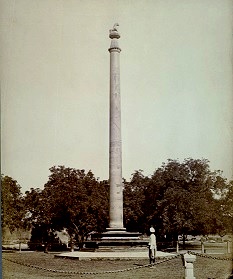
Ashoka Stambha (Pillar), Allahabad
It is well-known that Ilahabad (इलाहाबाद) is one of the two most ancient cities in India, but it is still surprising to see how far it dates back. The city is also known by its original name Prayag (प्रयाग) or Prayaga and is believed to be where Brahma offered his first sacrifice after creating the world. Prayaga is referenced to in the Vedas, the most ancient of Hindu sacred texts, and in the Puranas, another important group of religious texts.
Many artifacts were unearthed during excavations in Allahabad and were classified as 'Northern Black Polished Ware' dating back to around 700-200 BC. This also coincides with the rise of the Mauryan Empire of which king Ashoka was a part, During his reign, around 3rd century BC, he had many pillars inscribed with his edicts installed throughout India. The pillar in Allahabad is one of those that has survived. During those days most of the area known as Doab (Two Waters) including Prayaga consisted of dense continuous jungles except for a few huts at the confluence of the sacred rivers. Surrounded by the two rivers on 3 sides, the areas was very fertile with the annual floods from the rivers replenishing the topsoil.
The Mauryan empire was followed by Gupta's, and over the coming centuries many other empires, kingdoms, and dynasties were to come and go. One of the earlier written records about Allahabad were the memoirs of Huien Tsang, the Chinese Buddhist monk and chronicler who travelled through India during Harshavardhana's reign (607–647 AD) and visited Prayaga in 643 AD. In the memoirs he describes a ritual where hundreds took a bath in the confluence to wash away their sins. Some scholars theorize that this might have been the earliest account of Prayaga Khumb Mela while others point out that Harshavardhana was a Buddhist emperor and this probably was a Buddhist ritual.
Around the same time Muslim incursions into West Asia had been under way by Arabs under the Rashidun Caliphs, and by 642 AD they had wrested the control of most of the region from Sassanids and Byzantines, extending their rule from most of present day Pakistan to western Afghanistan with several pockets of local rulers here and there. Over the next few centuries, the Caliphates rule eventually waned, followed by Ghaznavid and then Ghorid dynasties battling for dominance while continuing the expansion through Punjab and some of the northern areas of present day India. Conversion from Hinduism or Buddhism to Islam was generally the trend in regions conquered by the Muslims.
Under the Ghaznavid rule their empire had extended to include Punjab. As the Ghorids moved in they pushed further east and established the Delhi Sultanate. Prayaga became a part of the Delhi Sultanate when it was annexed by Mohammad Ghori in 1193 AD.. It was almost 3 centuries later when the Mughals took over and under them Prayaga rose in prominence as the new rulers recognized its strategic importance specially in terms of the rivers providing critical transportation routes. During Emperor Akbar's reign Prayaga was renamed Ilahabad (Persian for 'place of God') in 1575 AD. A fort was built on the banks of the confluence and the city was also made a seat of the provincial government.
There are two items of note about the 1193 annexation by Ghori. First, it allowed several local non-Muslim rulers to retain their reigns. One such ruler was Raja Harbong of whom we talk about in our following story of Ulta Qila. Second, the eastward expansion of the Islamic rule resulted in a migration of several Muslim clans who had been settled in the western areas which had been under Islamic rule since the conquest by the Rashidun Caliphs. Pursuit of new fortunes or fertile lands may have been the reason for the migration, but the altruistic desire to promote the message of Islam was not an uncommon motive. One such group of about 40 people, some of whom were named Shaikhs, moved eastward to the Prayag area sometime during first half of 14th century AD. One member of this group is part of the following Ulta Qila story. Another member of this group, named Shaikh Minhaj Uddin, was our forefather.
If you look at the map at the top right of this page, you will see the town of Jhusi (also known as Jhunsi and Jhulsi, the Hindi word for 'burnt') on the east side of the confluence. This was where Pratisthan Pur or Pratisthan Puram was once located. It had been the capital of the Lunar Dynasty (Chandra Vanshi or Somavanshi) and was one of Prayag's important locality. Legend has it that there was a fort called 'Samudrakoop' which is described in Matsya Puran & Padm Puran and archaeologists believe that it was built during the reign of Samudra Gupta and hence the name. For a time the Jhusi was called Harbongpur after the local ruler Raja Harbong of whose cruelties, vagaries and misrule many fables are told.
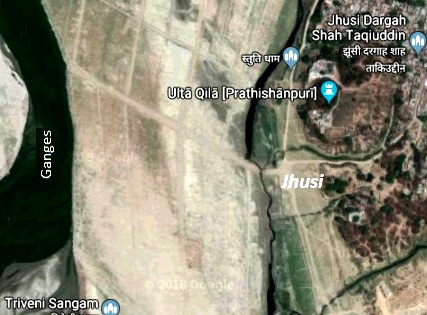
Jhusi satellite image showing the river, Ulta Qila, and Shaikh Taqi Baba's Dargah
It is believed that during Raja Harbong's rule the capital and fort was destroyed around 1359 AD and many explanations are available for the causes of destruction. One theory is that an earthquake and a fire caused the destruction. Another theory offers that foreign invaders (Muslims - who else?) brought about the destruction. According to some documents released by the Archaeological Department, this incidence happened due to the curses of Guru Gorakhnath, the disciple of Matseyndra Nath.
Another prevailing story is that the Raja maligned Shaikh Taqi Baba (also known as Makhdoom Ali Murtaza, Shaban ul-Millah Ali Murtaza or Mah-i Shaban Biyabani), a local saint, who cursed that the planet Mars fall on the Raja. Regardless of the cause of destruction, the fort was turned upside down and the entire ancient Pratisthan Pur became a cluster of mounds over an area of 4 square miles around the present day Jhusi. In place of the fort there stood a huge mound for nearly 5 centuries until 1855 when a temple and an ashram were built on the site. Fables aside, the archaeological excavations on the mound did unearth objects such as gold coins from the Gupta empire, a copper plate dating back to 1027 AD, and other objects indicating that the site under the mound was once inhabited before being abandoned.
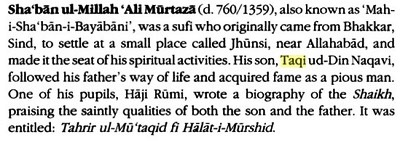
Excerpt from Page 548, 'Dictionary of Indo-Persian Literature'
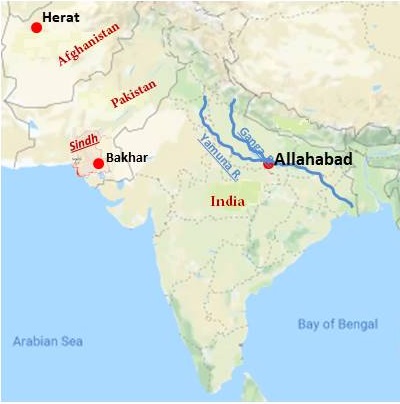
Our forefathers moved to Allahabad (Prayag then) from Bakhar, near Hyderabad, Sindh
We talked about Shaikh Taqi Baba in the Ulta Qila story above. The story is documented in multiple sources, some citing his name as Makhdoom Ali Murtaza or Mah-i Shaban Biyabani. Another source, 'Dictionary of Indo-Persian Literature' cites Taqi Uddin Naqavi as being Shaban Bayabani's son. An excerpt is shown on the right.
As mentioned previously, Shaban Biyabani was part of a group which had migrated east in the 13th century. According to the above excerpt they came from Bakhar which is near Hyderabad, Sindh, now part of Pakistan. There are also conflicting verbal accounts of their originating from Herat, a city in central western Afghanistan.
Conflicting reasons exist about their journey. One indication is that they went east at the behest of a ruler or a king and were awarded land grants in the Prayag area. A different inference is that their arrival and desire to settle down with some agricultural land was met by hostilities from the local powers-to-be leading to several battles and skirmishes. One such battle is described in Persian in a hand-written document.
The battle took place in Parastan Pur adjoining the Sangam. Raja Harbong, a cruel ruler, who then reigned over Parastan Pur had sent his armies to destroy the settlers who fought back fiercely with a group of fighters led by Shaikh Abdul Karim who, along with his brothers, was part of the group that had arrived from the west. Shaikh Abdul Karim was killed during the battle. His death so aggrieved Syed Shah Shaban Biyabani, another member of the migrant group and famed for his piety, that he cursed that the planet Mars fall on the Raja and his armies. As a result Parastan Pur sank into earth. The area is the present day Jhusi now.
Shaikh Abdul Karim's brother Shaikh Minhaj Uddin, who survived the battle, was our forefather. He appears to have settled in the lands on the north side of the Ganges river. His 7th generation descendant Shaikh Hasan Jaffri inhabited the village Jafri Nagar which was later called Chaphri. In time the Shaikh clan expanded south of the river to Asrauli and other villages. Some of our related families still live in Jhusi. Several miles northeast of Jhusi is the village of Malawan Khurd which is dominated by the Shaikh families. Eventually the generations of the Shaikh clan inhabited two dozen villages located along the both banks of river Ganges (Ganga) around the main city of Allahabad.
The Shaikhs had distinct characteristics and features. Over the centuries they tended to exclusively marry among their own families. In the beginning they spoke Persian but over time they developed their own distinct dialect that is a mixture of Urdu and Hindi with words from Persian, Arabic and Turkish, not found in either Urdu or Hindi. Their clothings conformed to Persian, Turkish and Afghan styles sometimes mixed with classical Hindu styles. In the beginning, turbans and beards were universal features with sprinklings of Turkish hat or Muslim Indian caps being worn. They were fiercely clannish with family and clan loyalty being a very strong trait. Personal honor and pride were highly valued. Men were expert horse riders often riding without saddles or bridles.
The Shaikhs were fearless warriors and were not daunted by the odds against them. There were numerous stories of bravery and fierce resistance to aggression from numerically-superior adversaries thus protecting their families or villages. These stories were not just a myth as during the 1950's and 60's some examples of such bravery were witnessed by the author. Infighting among Shaikhs was not uncommon and killings and revenge-killings have been known to occur for several generations, son taking revenge of father’s murder and so on. Education was usually oriented around the religious training, the higher education in the past had been limited to the head family of the clan, called Zamindars. A Zamindar could own an entire village or one Zamindar family could have owned several villages. The features of Shaikhs were North Indian but usually with lighter skin color. Interestingly, occasionally lighter grey or blue eyes have also been seen, and lighter brown or red hair are not unusual. They follow Sunni Hanfi Islam with a predilection towards Indian Sufism. Source of income was mostly farming of agriculture lands in the fertile plains of Ganga river. Ownership of cattle was universal, occasionally the families also owned camels. During the British period the Zamindars owned splendid two-horse and four-horse drawn carriages similar to those owned by British aristocrats. Pride of horse ownership sometimes ran afoul of British Officials who considered this an affront to their position (story to come in later pages).
In the beginning the men invariably used Shaiks as part of their names. Over a couple of centuries this practice waned. In later generations we see an adoption of the name Ahmed, and still later the name Siddiqui became vogue in some branches of the clan. In the Our Surnames, we take a closer look at the geneses of these names.
Compilation of this Shajrah has not been an easy task and many people have contributed to the information contained here. The task was originally started by several ancestors such as Haji Abdur Rashid of Shadyabad, ancestors from Mehdauri and Chaphri. Late Dr Rizwan Uddin Ahmad of Asrauli contributed a lot of his time, energy and efforts to compile major information without which the project would not have completed. His contributions included going through documents in the Persian language and translating them. We are grateful to all who have provided information, but a project of this magnitude may not be free of errors and omissions or missing information. Additional information, corrections and other materials will be most appreciated.
Multiple sources of data have been used in building the shajrah data. Unfortunately, quite a few names are incomplete. We did not find full names and in many instances we only found a nickname, e.g. Lallu. In addition, transcribing names from documents mostly in Urdu have introduced spelling errors. We do not intend disrespect to anyone and ask for corrections and/or information to remedy the shortcomings. Thank you.